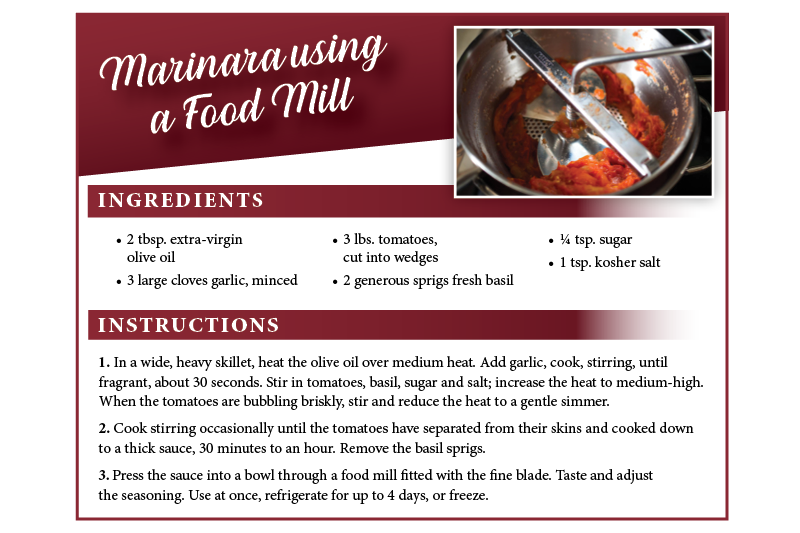Hello my Foodie Friends!
Early September begins the harvesting of summer plants. To harvest is considered a time to pick and gather what you sow. This season begins the time where farmers till their fields and ready the land for the next planting. Harvest time includes picking of foods such as cranberries, tomatoes, peppers, basil and Italian herbs, summer squash, corn, peaches, and apricots. Pureeing and canning many of these products has become a seasonal project for our foodies. Harvest making includes making apple/peach/pear butters, making tomato sauce and putting pureed pumpkin in the freezer.
From turning cooked apples into wholesome applesauce, freshly stewed tomatoes into a classic marinara, or steamed potatoes into a mash, the food mill proves its standing by being masterful with ingredients that are notoriously fussy to prep. Think of a food mill as being the low-tech version of a food processor—there’s no plug or motor, just a hand-crank that moves with a little help from you and your biceps. What can a food mill do that a processor can’t? Just ask any homesteader or canning enthusiast what their favorite time-saving tools are, and you can bet the food mill is right up there at the top of the list. This is because a foodmill can simultaneously purée and strain foods so efficiently that it renders the once tedious task of peeling fruit and vegetables obsolete.
A standard food mill consists of three parts: a bowl, a perforated plate that sits at the bottom, and the aforementioned hand-crank that is responsible for moving the metal blade that pushes the food through the plate. The result of this old-timey churning is a smooth purée without a seed, peel, pit, or stem in sight. The Food Mill is a tool that allows for fine and coarse milling. The changeable bottoms give you the ability to seed your harvest by the bushel. The food mill is a cross between a food processor and a sieve. You turn the handle and an angled blade presses the contents of the mill through a perforated disk, keeping any remnants like seeds or skin safely out of your puree. Unlike a food processor or a blender, a food mill does not incorporate air into the puree altering its texture. The result is a denser puree that is ideal for foods like applesauce or tomato sauce. Many of today’s food mills are designed to fit snugly over a vessel that catches the puree allowing you to mill in place with one hand while simultaneously cranking with the other.
Stop by Compliments to the Chef, your Neighborhood Kitchen and Cutlery store this harvest season to pick up the essentials you need for your culinary delights. Have a thrilling time milling your harvest. Happy milling!! Remember my Foodie Friends, “Life Happens in the Kitchen!”
Take Care,
John & Paula

